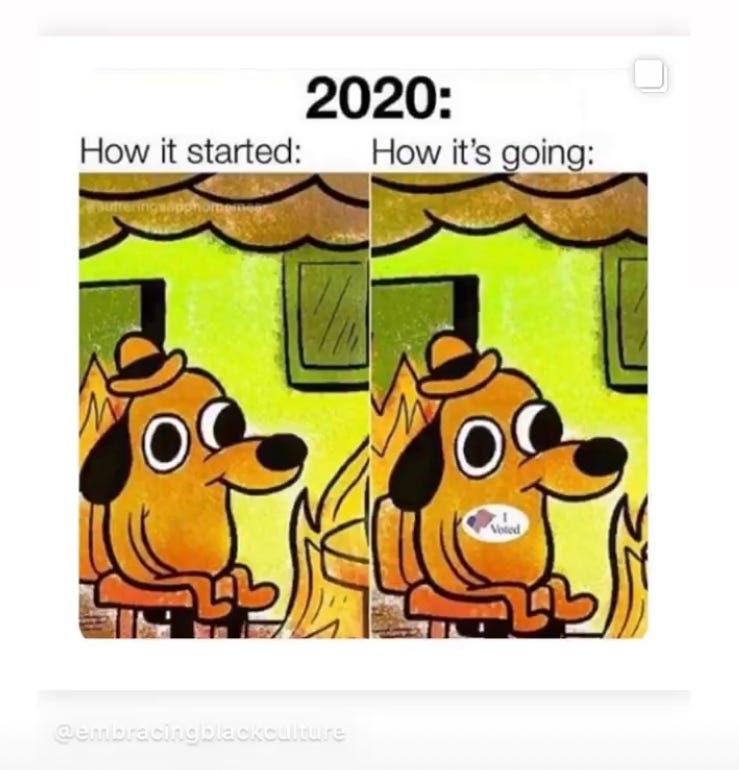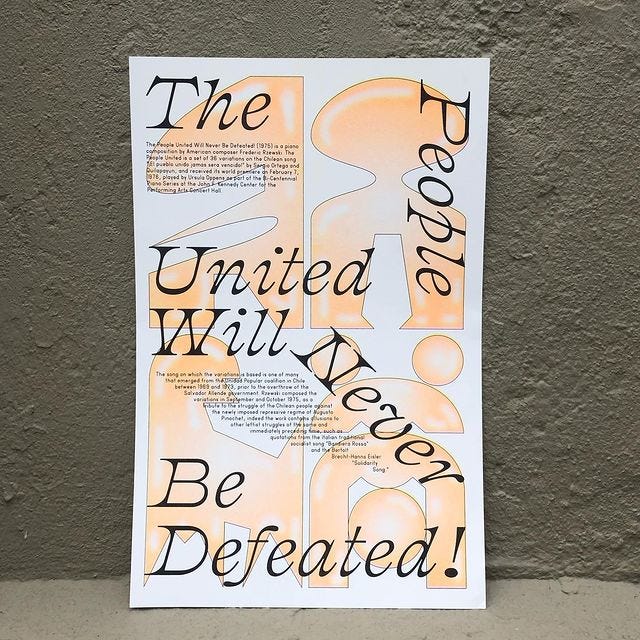18. 🗃️ instagram as archive (part 1)
thinking about archival practices & the collective relief we felt this weekend
Hi there! 👋 I’m Ida, and this is tiny driver, a newsletter about research, pedagogy, culture and their intersections. Thank you for being here. Reply anytime, I love hearing from you.
👋💖 And a big hello to the new subscribers!! I'm guessing that you are here because of the Anti-Racism Daily newsletter I wrote on higher education (I'll link it once it gets put into the archives). Thank you so much for subscribing to this little corner of the internet, and I'm so glad to have you here! Please also feel free to share this newsletter with friends that you think would like it too! 🥰
Well, I feel like we all can collectively exhale after four long years. The night of the election, I shared this post on my Instagram story:
On Saturday, I was reading at my desk when I started hearing honking and joyous shouts from my window. There was a little bit of hope in my heart as I googled "election results," and when I saw that Biden had gotten the EC vote, I felt such relief.
As many have said already, there is still so much work to be done. But on Saturday, I didn't think about that. I was just happy that we could move forward.
Also, I absolutely CACKLED when I saw this tweet. (And this definitely does reveal what I enjoy watching in my free time.)
Today's newsletter is going to be a little "drafty-er" than usual because I want to enjoy this first morning waking up and knowing that 45 is on his way out.
What I write.
I'm interested in thinking for the next couple of weeks about "instagram as archive" or collection. This week, I'm going to give some context to what I'll be thinking about, as well as some questions that I'd love you to help me answer. I'm thinking that they can be conversation starters (what I've written here is still quite half-baked and I plan to think more about it as the week goes on), so I'd love for you to tell me what comes to mind when you think about Instagram and archives! ☺️🗃️
Content.
As I'm sure we all do, I follow a wide array of people, organizations and things on Instagram. Aside from following my friends, I also love following meme accounts, illustrator accounts, accounts about academia (s/o to not so ivory tower) the stray influencer, etc. etc. The list truly does go on, as I'm sure you all can relate to. And yet, there are always certain posts that I stop and stare at a little more. Call it the historian in me, but I love posts that feature photographic images or material culture that is not necessarily about the person or entity that I am following. Usually it features old photographs or documents from the past, but I've also been drawn to certain zine culture accounts as well.
I love these accounts that document and curate visual material. Granted, that last sentence could invariably be used to describe all of Instagram, but there's a particular way that some accounts adhere to a sort of citational practice that always intrigues me. There's my friend Randa's account, @tiny historian. Or, even take @retrofuturistnomad:
Recent posts from the account feature an intriguing collection of images. Some are photographs of life in the Qajar and Pahalvi era of Iran, others are of garments that seem fit for a museum exhibit. But the real treat are the Instagram Story highlights, where the person behind ★ yār ★ has curated a specific set of "vibes" that speak to certain affects.
The way in which these accounts curate material to fit certain styles or structures of feeling is something that I think is particularly effective on this platform (more so than Pinterest, which is the other platform that I think adheres to curation).
Form.
And then there's the fact that you can save posts you like to different "Collections" based on your own interests. This, to me, is such an interesting component. Again, it's something that platforms like Pinterest already do, but it feels like there is something so much more streamlined about the process on Instagram—so much more uniform. And potentially less overwhelming? The fact that Instagram collections are limited to the platform, whereas Pinterest encompasses the entire internet is something that I think allows me to feel like the project of collection is still manageable.
I have found the collections tab to almost tell me a story of my recent life and what has been most important to me at certain points in time. And I have also found it a place where I get ideas for dynamics and moments that I'd like to think more about for my research or my teaching. In fact, I have saved multiple posts that I think would be an interesting conversation opener for classes. Like this one from June:
I'm teaching a class in the Spring called "Asian Americans and Third World Solidarity," where we're going to be exploring the history of Asian American cross-coalition organizing in the twentieth century. Currently, their final project is to create an "Instagram resource guide" on a topic having to do with the larger themes of the course. You know, the ones that have been all over instagram since this past summer. The ones that also made their way into this amazingly well-articulated article by Terry Nguyen that I shared earlier this summer.
Although I am asking them to make a resource guide, I'm hoping that along the way, we can dig deeper into this phenomenon. Specifically, I want us to ask questions. Lots of questions. What larger structural gaps do these guides reveal? What is the significance of the colors, fonts, way that the information is presented? Are there citations or bibliographies? What are the pros & cons of this phenomenon, and can it be justified, despite the flaws? How does capitalism play into this practice, given that it is on a social media platform that can't control what appears around these guides? The list goes on and on. But at least I have an arsenal of "saved" posts to draw on for close readings and guiding discussions.
⚡🗃️ Questions for you! 🗃️⚡
Now that I've written a bit about what I'm thinking through, I'd love to hear from you!
Please feel free to give me your thoughts on Instagram & its various features, either by replying directly to this email (private) or by leaving a public comment!
If you'd like some guiding questions, I'd love to hear about your thoughts on:
Instagram as archive // the "saving" feature
Instagram stories vs. Instagram posts
How you personally interact with Instagram
Your thoughts on Instagram resource guides (esp. in light of the BLM movement)
My final project for my spring course—do you think the students will be into it?!
I'm looking forward to hearing from you! ☺️
What I consume.
In the Bookshop:
Currently Reading: Luster by Raven Leilani
On Deck: The Vanishing Half by Brit Bennett
Item(s) of note.

A lovely chart of DIY Spice Blends.
My new favorite newsletter on making bread.
Another new favorite newsletter: "a self-care survival guide for technologists"
A remake of Cassie's "Me & U" that is so, so good:
A pup-date.
Tell me this isn't accurate:

As always, thanks so much for reading through, and I'll see you in the next one.
Warmly,
Ida











I saw the subject 'instagram as archive' some time ago, and while I didn't have time to open the email immediately, I've been doing a little thinking about Instagram.
1. My instagram is basically an art account. I've been doing this for about nearly a year and a half and I really like being able to scroll through my feed and see all the art styles I've been through. Also, because I only post when I make art, it's like an archive of creative months and lean months.
2. For me, Pinterest boards (and later, Instagram saved folders) always start out with the goal of curation, but I eventually catch myself saving *everything* in random folders. I never actually go back and see what I've saved, but I like looking at old, abandoned pinterest boards as testimonies to the hobbies I used to have and the Johanna I used to be.
3. The only pinterest board I use regularly is my art inspiration board. For some reason, when I'm done with a piece, I delete the original art or photos that inspired it from my pinterest board. I think it began as an attempt to keep the board manageable (it currently has over 2k pins) but now it's a kind of finishing-art ritual.
I never experienced a 'zine-culture' so I like to think of Instagram resource guides as the modern zines.